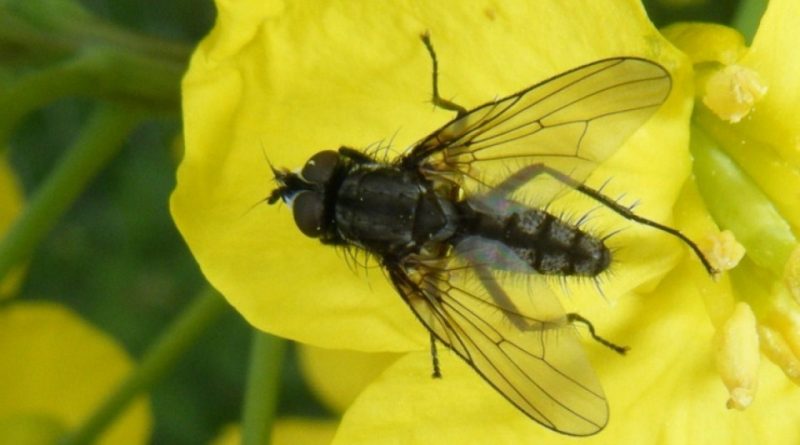Delia platura
Delia platura
The seedcorn maggot or bean seed fly (Delia platura Meigen, 1826) is a dipteran belonging to the Anthomyiidae family.
Systematics –
From a systematic point of view it belongs to:
Eukaryota Domain,
Kingdom Animalia,
Sub-kingdom Eumetazoa,
Phylum Arthropoda,
Subphylum Tracheata,
Superclass Hexapoda,
Insecta class,
Subclass Pterygota,
Endopterygota cohort,
Superorder Oligoneoptera,
Panorpoidea section,
Diptera Order,
Suborder Brachycera,
Cyclorrhapha cohort,
Schizophora Section,
Calyptratae subsection,
Superfamily Muscoidea,
Anthomyiidae family,
Genus Delia
Species D. platura.
The terms are synonymous:
– Anthomyia platura Meigen, 1826;
– Hylemyia platura Meigen, 1826;
– Chorthophila cilicrura Róndani, 1866;
– Chortophila cilicrura Róndani, 1866;
– Phorbia platura Meigen 1826.
Geographic Distribution and Habitat –
The bean seed fly is a polyphagous insect that lives in a vast typology of environments and where it lives at the expense of over 40 plant species; among these we find: Bean, Melon, Watermelon, Spinach, Asparagus, Tomato, Cereals, Tobacco, Gladiolus (Gladiolus), Carnation (Dianthus), Fir (Abies), Maple (Acer), etc. and also, in some conditions, it is added to the damage caused by other rodents, such as in the case of Radicchio, Turnip, Onion, Potato, etc.
Morphology –
The bean seed fly is a small dipteran, a few mm long, yellowish gray, with apodic and whitish larvae.
Adults measure 3 to 6mm in length. They have a yellowish gray chest as well as the abdomen; both are decorated with a brownish median longitudinal band; the legs are black.
The eggs have a white mother-of-pearl color, elongated in shape and measure about 1 mm in length.
The larvae are whitish in color with a length of 5 – 8 mm when fully developed. They have the last segment obliquely truncated.
The pupae are brown-red in color and measure around 5mm in length.
Attitude and Life Cycle –
The bean seed fly overwinters as a pupa in the ground. At the end of winter and especially in the period of April-May, adults begin to flicker oviposition at ground level; the newborn larvae, if they find the host plants, cause the damage described.
The female of this diptera lays hundreds of eggs in the soil, very often in isolation. The fly prefers to lay in very humid soils, rich in organic matter and recently worked, even if there are no host plants.
Once the eggs are laid, the embryonic evolution lasts a few days.
The larva has a development of 3 weeks and feeds on decaying animal or vegetable materials, on which it can carry out all its development. Despite this, attracted by germinating grains and young plants, it tends to penetrate inside by digging tunnels in the cotyledons, small stems and young shoots before leaving the ground. When the plant is more developed, its tissues are too hard for the tissues to attack, and the dangerous period does not exceed three or four weeks. The larvae pass to the nymph stage in the soil in the form of pupae at varying depths.
In total there can be from 3 to 6 generations during the year depending on the climatic conditions and latitude and altitude; the duration of the cycle varies according to the temperature (+ 10 ° C: 85 days; + 20 ° C: 24 – 25 days; + 25 ° C: 16 – 17 days). The pupae overwinter in the soil and the adults appear from the end of winter and especially in spring but in the southern regions, they are present all year round.
The damage occurs on the shoots or on young seedlings and is due to the presence of the larvae that dig tunnels or undermine the cotyledons and the feathers. In the case of serious infestations, especially in nursery seedlings, significant failures can occur.
Ecological Role –
The Delia platura, in conditions of high infestation, can cause damage to crops of agricultural interest.
The larvae destroy the germs of grains or bulbs in the course of development and of the transplanted plants. They often cause the plant to rot, resulting in the more or less total destruction of seeds or plantations. On Asparagus, the attached shoots are deformed, often burst and have a bitter taste.
The damages are linked to the population density of the larvae and to the characteristics of the soils, such as recently worked soils and richness of organic matter.
Furthermore, the low temperatures and the excessive depth of the seeds, by decreasing the vigor of the young seedlings, favor larval activity.
Until recently, the fight against Delia platura was a chemical type and was carried out by geodisinfestation with fumigants or with granular formulation products, or with an all-out intervention by sprinkling insecticide immediately after sowing. In addition, interventions were also performed at later times, with the use of medium specific products against Diptera larvae; in this case the treatment consisted of localized insecticidal spraying.
In recent times, with the greater understanding of the biocenosis of beneficial insects and with the application of agroecological techniques, it has been understood instead that it is necessary to act both on the agronomic conditions (decrease in fresh inputs of organic matter, lower humidity of the soils) but above all with the decrease in crop specializations, by inserting rotations and associations with insensitive species.
Guido Bissanti
Sources
– Wikipedia, the free encyclopedia.
– Russo G., 1976. Agricultural Entomology. Special Part. Liguori Editore, Naples.
– Tremblay E., 1997. Applied entomology. Liguori Editore, Naples.

